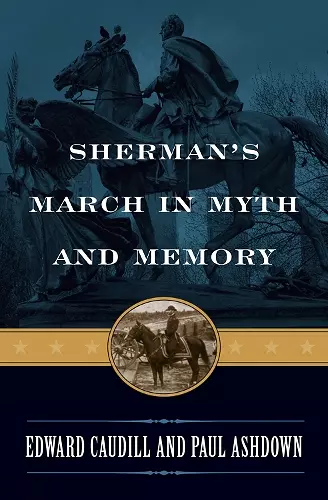Sherman's March in Myth and Memory
Paul Ashdown author Edward Caudill author
Format:Hardback
Publisher:Bloomsbury Publishing PLC
Published:27th Jun '08
Currently unavailable, and unfortunately no date known when it will be back
This hardback is available in another edition too:
- Paperback£25.00(9780742550285)

General William Tecumseh Sherman's devastating "March to the Sea" in 1864 burned a swath through the cities and countryside of Georgia and into the history of the American Civil War. As they moved from Atlanta to Savannah—destroying homes, buildings, and crops; killing livestock; and consuming supplies—Sherman and the Union army ignited not only southern property, but also imaginations, in both the North and the South. By the time of the general's death in 1891, when one said "The March," no explanation was required. That remains true today.
Legends and myths about Sherman began forming during the March itself, and took more definitive shape in the industrial age in the late-nineteenth century. Sherman's March in Myth and Memory examines the emergence of various myths surrounding one of the most enduring campaigns in the annals of military history. Edward Caudill and Paul Ashdown provide a brief overview of Sherman's life and his March, but their focus is on how these myths came about—such as one description of a "60-mile wide path of destruction"—and how legends about Sherman and his campaign have served a variety of interests.
Caudill and Ashdown argue that these myths have been employed by groups as disparate as those endorsing the Old South aristocracy and its "Lost Cause," and by others who saw the March as evidence of the superiority of industrialism in modern America over a retreating agrarianism.
Sherman's March in Myth and Memory looks at the general's treatment in the press, among historians, on stage and screen, and in literature, from the time of the March to the present day. The authors show us the many ways in which Sherman has been portrayed in the media and popular culture, and how his devastating March has been stamped into our collective memory.
This book is a valuable resource. The breadth of coverage—history, literature, poetry, song, stage, and screen—is extremely impressive. * Civil War Book Review *
Having read the first two excellent books—on Forrest and Mosby—in this unique trilogy, I opened this final book with high expectations of a masterful achievement. In both fact and myth, Sherman was and clearly still is multifaceted. On the eve of the Civil War Sesquicentennial, Caudill and Ashdown eloquently render a multifaceted portrait of a hell of a man. -- David Madden, founding director of the United States Civil War Center
As is often true in our history, the mythology of major events has a history of its own, shaping our visions of the past. Edward Caudill and Paul Ashdown have traced this Civil War scar in Southern memory to its roots in reality, in memoirs, in histories, in the press, and in mythology, basing their story on rich primary sources and portraying events with the same elegant language they have used in other important Civil War interpretative histories. -- Donald L. Shaw, University of North Carolina at Chapel Hill
A major contribution to Civil War historiography. . . cannot be overlooked. Recommended for all history collections—Civil War, social, or intellectual—in all libraries. * Library Journal *
Integral to the study of public history and collective memory to deliver a cutting-edge analysis. * America's Civil War *
Perhaps the most impressive thing about mass media is their ability to shape historical memory and imagination. Sherman's March in Myth and Memory is one of the best examples now available that shows how this phenomenon works in transforming a region's understanding of itself. Professors Caudill and Ashdown are to be highly commended for this first rate work. -- Bruce J. Evensen, DePaul University
Interesting and exceptionally well-sourced. . . . Thoroughly enjoyable. It provides a worthy new addition to the now burgeoning field of scholarship about media and public memory and would be useful not only to historians but in graduate seminars for students of both history and mass communication. * Journalism History *
Recommended. * Book Review Digest *
The images of Gen. William T. Sherman's men marching through Georgia seemingly remain burned into the American historical memory. Edward Caudill and Paul Ashdown here provide their solidly researched look at how the myth and legends of the march have been created. Works such as this provide an important starting place for further study of those myths that still march on. -- James Klotter * Journal of American History *
Caudill and Ashdown have constructed a useful book, filled with examples from humor and popular culture that reveal Sherman's place in history and memory. Such memory studies pertaining to the Civil War enable us to better grasp the complexities of this defining moment in American history. * Journal of Southern History *
- Winner of ForeWord Book of the Year Finalist 2009.
ISBN: 9780742550278
Dimensions: 241mm x 160mm x 21mm
Weight: 513g
240 pages